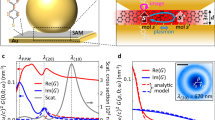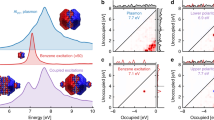Abstract
The exceptional enhancement of Raman scattering by localized plasmonic resonances in the near field of metallic nanoparticles, surfaces or tips (SERS, TERS) has enabled spectroscopic fingerprinting down to the single molecule level. The conventional explanation attributes the enhancement to the subwavelength confinement of the electromagnetic field near nanoantennas. Here, we introduce a new model that also accounts for the dynamical nature of the plasmon–molecule interaction. We thereby reveal an enhancement mechanism not considered before: dynamical backaction amplification of molecular vibrations. We first map the system onto the canonical Hamiltonian of cavity optomechanics, in which the molecular vibration and the plasmon are parametrically coupled. We express the vacuum optomechanical coupling rate for individual molecules in plasmonic ‘hot-spots’ in terms of the vibrational mode's Raman activity and find it to be orders of magnitude larger than for microfabricated optomechanical systems. Remarkably, the frequency of commonly studied molecular vibrations can be comparable to or larger than the plasmon's decay rate. Together, these considerations predict that an excitation laser blue-detuned from the plasmon resonance can parametrically amplify the molecular vibration, leading to a nonlinear enhancement of Raman emission that is not predicted by the conventional theory. Our optomechanical approach recovers known results, provides a quantitative framework for the calculation of cross-sections, and enables the design of novel systems that leverage dynamical backaction to achieve additional, mode-selective enhancements. It also provides a quantum mechanical framework to analyse plasmon–vibrational interactions in terms of molecular quantum optomechanics.
This is a preview of subscription content, access via your institution
Access options
Subscribe to this journal
Receive 12 print issues and online access
$259.00 per year
only $21.58 per issue
Buy this article
- Purchase on Springer Link
- Instant access to full article PDF
Prices may be subject to local taxes which are calculated during checkout




Similar content being viewed by others
References
Fleischmann, M., Hendra, P. & McQuillan, A. Raman spectra of pyridine adsorbed at a silver electrode. Chem. Phys. Lett. 26, 163–166 (1974).
Jeanmaire, D. L. & Van Duyne, R. P. Surface Raman spectroelectrochemistry Part I. Heterocyclic, aromatic, and aliphatic amines adsorbed on the anodized silver electrode. J. Electroanal. Chem. Interfacial Electrochem. 84, 1–20 (1977).
Kneipp, K. et al. Single molecule detection using surface-enhanced Raman scattering (SERS). Phys. Rev. Lett. 78, 1667–1670 (1997).
Nie, S. Probing single molecules and single nanoparticles by surface-enhanced Raman scattering. Science 275, 1102–1106 (1997).
Shalaev, V. & Sarychev, A. Nonlinear optics of random metal–dielectric films. Phys. Rev. B 57, 13265–13288 (1998).
Pettinger, B., Schambach, P., Villagomez, C. J. & Scott, N. Tip-enhanced Raman spectroscopy near-fields acting on a few molecules. Annu. Rev. Phys. Chem. 63, 379–399 (2012).
Sharma, B. et al. High-performance SERS substrates: advances and challenges. MRS Bull. 38, 615–624 (2013).
Qian, X. M. & Nie, S. M. Single-molecule and single-nanoparticle SERS from fundamental mechanisms to biomedical applications. Chem. Soc. Rev. 37, 912–920 (2008).
Luo, Y., Aubry, A. & Pendry, J. B. Electromagnetic contribution to surface-enhanced Raman scattering from rough metal surfaces: a transformation optics approach. Phys. Rev. B 83, 155422 (2011).
Kneipp, K. et al. Population pumping of excited vibrational states by spontaneous surface-enhanced Raman scattering. Phys. Rev. Lett. 76, 2444–2447 (1996).
Maher, R. C. et al. Stokes/anti-Stokes anomalies under surface enhanced Raman scattering conditions. J. Chem. Phys. 120, 11746 (2004).
Maher, R. C., Galloway, C. M., Le Ru, E. C., Cohen, L. F. & Etchegoin, P. G. Vibrational pumping in surface enhanced Raman scattering (SERS). Chem. Soc. Rev. 37, 965–979 (2008).
Zhang, R. et al. Chemical mapping of a single molecule by plasmon-enhanced Raman scattering. Nature 498, 82–86 (2013).
Zhu, W. & Crozier, K. B. Quantum mechanical limit to plasmonic enhancement as observed by surface-enhanced Raman scattering. Nature Commun. 5, 5228 (2014).
Jiang, S. et al. Distinguishing adjacent molecules on a surface using plasmon-enhanced Raman scattering. Nature Nanotech. 10, 865–869 (2015).
Atkin, J. M. & Raschke, M. B. Techniques: optical spectroscopy goes intramolecular. Nature 498, 44–45 (2013).
Kippenberg, T. J. & Vahala, K. J. Cavity optomechanics back-action at the mesoscale. Science 321, 1172–1176 (2008).
Braginsky, V. & Manukin, A. Ponderomotive effects of electromagnetic radiation. Sov. Phys. JETP 25, 653–655 (1967).
Kippenberg, T., Rokhsari, H., Carmon, T., Scherer, A. & Vahala, K. Analysis of radiation-pressure induced mechanical oscillation of an optical microcavity. Phys. Rev. Lett. 95, 033901 (2005).
Aspelmeyer, M., Kippenberg, T. J. & Marquardt, F. Cavity optomechanics. Rev. Mod. Phys. 86, 1391 (2014).
Gorodetsky, M. L., Schliesser, A., Anetsberger, G., Deleglise, S. & Kippenberg, T. J. Determination of the vacuum optomechanical coupling rate using frequency noise calibration. Opt. Express 18, 23236–23246 (2010).
Van Laer, R., Kuyken, B., Baets, R. & Van Thourhout, D. Unifying Brillouin scattering and cavity optomechanics. Preprint at http://arXiv.org/abs/1503.03044 (2015).
Shalabney, A. et al. Coherent coupling of molecular resonators with a microcavity mode. Nature Commun. 6, 5981 (2015).
Long, J. P. & Simpkins, B. S. Coherent coupling between a molecular vibration and Fabry–Perot optical cavity to give hybridized states in the strong coupling limit. ACS Photon. 2, 130–136 (2015).
Koenderink, A. F. On the use of Purcell factors for plasmon antennas. Opt. Lett. 35, 4208–4210 (2010).
Schliesser, A. & Kippenberg, T. J. in Advances in Atomic, Molecular, and Optical Physics Vol. 58 (eds Berman, P., Arimondo, E. & Lin, C.) Ch. 5, 207–323 (Academic, 2010).
Le Ru, E. C. & Etchegoin, P. G. in Principles of Surface-Enhanced Raman Spectroscopy Ch. 6, 299–365 (Elsevier, 2009).
Boyd, R. Nonlinear Optics (Elsevier Science, 2003).
Botter, T., Brooks, D. W. C., Brahms, N., Schreppler, S. & Stamper-Kurn, D. M. Linear amplifier model for optomechanical systems. Phys. Rev. A 85, 013812 (2012).
Wilson-Rae, I., Nooshi, N., Zwerger, W. & Kippenberg, T. J. Theory of ground state cooling of a mechanical oscillator using dynamical backaction. Phys. Rev. Lett. 99, 093901 (2007).
Galland, C., Sangouard, N., Piro, N., Gisin, N. & Kippenberg, T. J. Heralded single-phonon preparation, storage, and readout in cavity optomechanics. Phys. Rev. Lett. 112, 143602 (2014).
Wilson, E., Decius, J. & Cross, P. Molecular Vibrations: The Theory of Infrared and Raman Vibrational Spectra (Dover, 1955).
Chan, J., Safavi-Naeini, A. H., Hill, J. T., Meenehan, S. & Painter, O. Optimized optomechanical crystal cavity with acoustic radiation shield. Appl. Phys. Lett. 101, 181115 (2012).
Camden, J. P. et al. Probing the structure of single-molecule surface-enhanced Raman scattering hot spots. J. Am. Chem. Soc. 130, 12616–12617 (2008).
Schliesser, A., Del'Haye, P., Nooshi, N., Vahala, K. J. & Kippenberg, T. J. Radiation pressure cooling of a micromechanical oscillator using dynamical backaction. Phys. Rev. Lett. 97, 243905 (2006).
Mandel, L. & Wolf, E. Optical Coherence and Quantum Optics (Cambridge Univ. Press, 1995).
Wilson-Rae, I., Nooshi, N., Dobrindt, J., Kippenberg, T. J. & Zwerger, W. Cavity-assisted backaction cooling of mechanical resonators. New J. Phys. 10, 095007 (2008).
Kenkre, V., Tokmakoff, A. & Fayer, M. Theory of vibrational relaxation of polyatomic molecules in liquids. J. Phys. Chem. 101, 10618–10629 (1994).
Savage, K. J. et al. Revealing the quantum regime in tunnelling plasmonics. Nature 491, 574–577 (2012).
Scholl, J. A., Garca-Etxarri, A., Koh, A. L. & Dionne, J. A. Observation of quantum tunneling between two plasmonic nanoparticles. Nano Lett. 13, 564–569 (2013).
Kipf, T. & Agarwal, G. S. Superradiance and collective gain in multimode optomechanics. Phys. Rev. A 90, 053808 (2014).
Kasperczyk, M., Jorio, A., Neu, E., Maletinsky, P. & Novotny, L. Stokes–anti-Stokes correlations in diamond. Opt. Lett. 40, 2393–2396 (2015).
Liu, N. et al. Plasmonic analogue of electromagnetically induced transparency at the drude damping limit. Nature Mater. 8, 758–762 (2009).
McFarland, A. D., Young, M. A., Dieringer, J. A. & Van Duyne, R. P. Wavelength-scanned surface-enhanced Raman excitation spectroscopy. J. Phys. Chem. B 109, 11279–11285 (2005).
Zuloaga, J. & Nordlander, P. On the energy shift between near-field and far-field peak intensities in localized plasmon systems. Nano Lett. 11, 1280–1283 (2011).
Moreno, F., Albella, P. & Nieto-Vesperinas, M. Analysis of the spectral behavior of localized plasmon resonances in the near- and far-field regimes. Langmuir 29, 6715–6721 (2013).
Esteban, R. et al. The morphology of narrow gaps modifies the plasmonic response. ACS Photon. 2, 295–305 (2015).
Weis, S. et al. Optomechanically induced transparency. Science 330, 1520–1523 (2010).
Andrews, R. et al. Bidirectional and efficient conversion between microwave and optical light. Nature Phys. 10, 321–326 (2014).
Schmidt, M., Esteban, R., Gonzalez-Tudela, A., Giedke, G. & Aizpurua, J. QED description of Raman scattering from molecules in plasmonic cavities. Preprint at http://arXiv.org/abs/1509.03851 (2015).
Acknowledgements
The authors thank P. Fischer, H.-H. Jeong, V. Sudhir, D. Wilson and E. Verhagen for discussions and C. Corminboeuf and E. Bremond for help with running the chemical simulations. This work was partially supported by an ERC Advanced Grant (QREM), the NCCR of Quantum Engineering (QSIT) as well as the Swiss National Science Foundation. P.R. acknowledges the support of the Max Planck-EPFL Center for Molecular Nanoscience and Technology. C.G. acknowledges the support of the Swiss National Science Foundation through an Ambizione Fellowship. N.P. acknowledges the support of a Marie-Curie Fellowship.
Author information
Authors and Affiliations
Contributions
P.R., C.G. and T.J.K. conceived the study. P.R. and C.G. developed the model and performed the calculations. P.R., C.G. and T.J.K. co-wrote the paper. All authors discussed and analysed the results.
Corresponding authors
Ethics declarations
Competing interests
The authors declare no competing financial interests.
Supplementary information
Rights and permissions
About this article
Cite this article
Roelli, P., Galland, C., Piro, N. et al. Molecular cavity optomechanics as a theory of plasmon-enhanced Raman scattering. Nature Nanotech 11, 164–169 (2016). https://doi.org/10.1038/nnano.2015.264
Received:
Accepted:
Published:
Issue Date:
DOI: https://doi.org/10.1038/nnano.2015.264
This article is cited by
-
Measurement-induced collective vibrational quantum coherence under spontaneous Raman scattering in a liquid
Nature Communications (2023)
-
Giant optomechanical spring effect in plasmonic nano- and picocavities probed by surface-enhanced Raman scattering
Nature Communications (2023)
-
Direct characterization of shear phonons in layered materials by mechano-Raman spectroscopy
Nature Photonics (2023)
-
Large-Area, Ultrahigh-Enhancement, and Array-Type Hot Spots in Plasmonic Nanocube Dimer-on-Film Nanocavity
Plasmonics (2023)
-
Single molecule photonic transistor and router through plasmonic nanocavity
Applied Physics B (2023)



